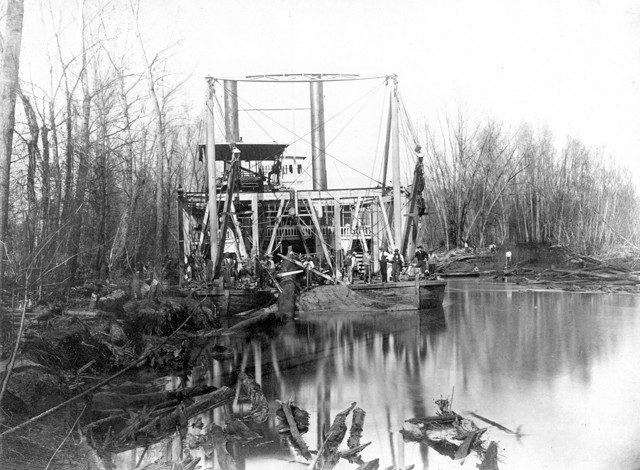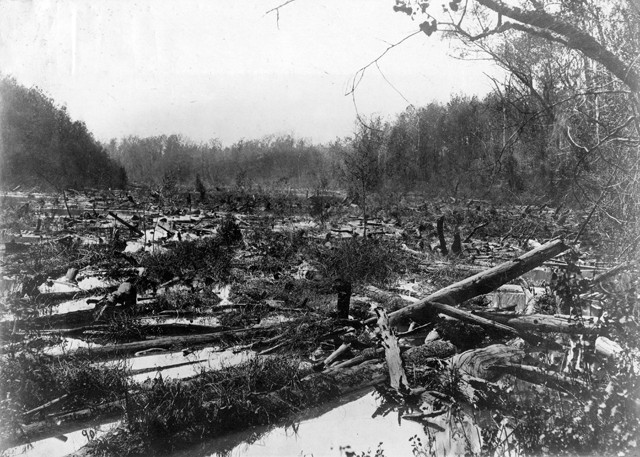
by David B. Williams Monday, June 20, 2016
Throughout the 1800s, America’s eastern and southeastern coastal rivers acted as highways for shipping. Generally winding with shallow slopes, the rivers could be plied easily by barges and steamboats, but one particular water body — the main channel of the Red River that runs from Arkansas through Louisiana — thwarted the plans of shippers for much of the 19th century. A massive entanglement of logs, stumps and branches, known as the Great Raft, blocked the Red from Fulton, Ark, to about Shreveport, La. But on Nov. 27, 1873, after more than 40 years of trying, the raft was destroyed and boats could travel unimpeded down the main channel of the Red River.
River geomorphologists know of no other riparian obstruction like the Great Raft of the Red River. Varying accounts throughout the 1800s suggest the Great Raft stretched for between 82 and 225 kilometers and consisted of smaller rafts ranging in length from 100 to 1,600 meters. In some cases the raft was so dense that it effectively masked the river itself; early reports noted that “the river may be frequently passed without any knowledge of its existence.”
Thousands of years ago, the Red River was a classic meandering stream that wound sinuously in a single channel down a gentle slope. But about 2,000 years ago, the Mississippi River shifted channels so that it connected with the Red River, says Danny Harrelson, a hydrologist at the U.S. Army Corps of Engineers in Vicksburg, Miss. At the confluence of the two rivers, a knickpoint — a point of abrupt change in a river valley — formed, slowing the rush of water in the Red River and causing the riverbank to collapse, choking the river with the shrubs and trees that once grew along its banks. Over time the additional logs and stumps snagged on the river bottom; wood then collected behind the obstacles and created dams. The dams further restricted the flow of water, so that the river-borne sediments settled out of the water, raising the riverbed — and the level of the river. Subsequent flooding led to the development of distributaries, or bayous as they are known regionally, and lakes.
The bayous and lakes formed because the rafts caused the river to act like a car seeking a way out of a traffic jam on a freeway: As the river water backed up, it would try to avoid the downstream blockage by spilling out to the side and taking new routes that paralleled the main channel, sometimes spreading between 30 and 50 kilometers across the floodplain. These bayous flowed for kilometers — and for years. Some eventually got cut off and drained as the escape outlet became blocked. Others formed lakes as a new jam dammed the downstream exit point.

The U.S. Army Corps of Engineers used steamer ships with powerful cranes and a platform to cut up the logs to remove portions of the Great Red River Raft, but it wasn't until they started using nitroglycerin in 1873 that they made a big dent. Credit: R.B. Talfor, U.S. Geological Survey photographic library.

One of several timber jams composing the Great Red River Raft in 1873; this photo was taken close to the Arkansas-Louisiana border. Where the raft blocked water from flowing, silt accumulated rapidly and filled the river channel. Credit: R.B. Talfor, U.S. Geological Survey photographic library.
The Great Raft was not static; it migrated up the river as the logs decayed at the lower end and accumulated at the upper end. Joseph Paxton, a doctor who lived near the Red River in Arkansas, noted in a letter to his congressional delegate in 1828 that the river advanced “like a destroying angel, spreading desolation over a most lovely country.” The raft’s ever-changing position caused many of the lakes to drain as an outlet reopened, but a few remained intact when enough debris and sediment accumulated at the outlet to form a more permanent dam. The most famous of these is Caddo Lake, which starts in Louisiana and backs up into Texas, forming the state’s only natural lake.
Some boats did exploit the bayous and lakes as travel routes, but the journeys were often challenging or deadly: Boats sank when they hit snags. Furthermore, the logjam made it difficult for settlers in the upper Red River Valley; by 1831, the War Department had established two posts to help protect the settlers from Native Americans, and an open river would be the easiest means of transporting supplies to these posts. The raft had to go.
In 1828, Congress appropriated $25,000 to remove the raft, with more money approved in 1832. To remove the raft, the Army Corps of Engineers turned to Capt. Henry Shreve, one of the principal inventors of the snagboat. Nicknamed “Uncle Sam’s Toothpullers,” these boats had a steam-powered hoist sitting atop double hulls, between which ran a heavy beam. To remove a snag, the boat ran full steam at it, caught the tree or stump on the cross beam, and forced it out of the water. The snag either loosened or broke, or was plucked with the hoist and sawed into harmless pieces that were either floated downstream or removed from the river and used to backfill a bayou.
Shreve arrived at the base of the Great Raft on April 11, 1833, with 159 men and four boats, including his snagboat Archimedes. The next day he wrote, “I am now about five miles through it. I have found it, thus far, easily removed … I have no doubt but I could remove the whole raft in sixty-six days.” By May 8, his men had removed 31 sections of raft and cleared 64 kilometers of river. They also cut away trees growing on the river banks and islands, or towheads as they were called. He noted: “As relates to the practicability of effecting a complete and permanent improvement, there is no longer a doubt; I view it certain of success.”
Shreve stopped work on June 23, after removing 114 kilometers of raft. Traveling back downriver, he found that the channel had deepened at least 3 meters and that the current flowed 12 times faster than before. More than 100 kilometers of raft remained, but with an additional $100,000, success was certain, he said.
The following year, however, Congress supplied only $50,000. In addition, the raft had started to regrow and several dams in the bayous had broken and allowed wood to rejoin the remaining rafts. Two years later, in 1836, Shreve reported that just 14 kilometers of raft remained but that the last 50 kilometers had taken as much effort as the previous 193. Parts of the raft were so dense that they “had more the appearance of a forest than a river,” he wrote in his official report. Still, with a further $40,000, he hoped to have the river completely cleared by April 1837. He was only off by a year.
By May 1, 1838, the Great Raft was gone and “navigation through the whole extent of the raft was considered safe,” Shreve wrote. Large boats began to move upriver. But nature had not been defeated. A lack of funding prevented upkeep on the river, and by the following April, a new raft had grown to 2,000 meters. Congress balked at sending more money. Despite the expenditure of more than half a million dollars, the raft had won. Over the next 30 years, little money and little effort went toward raft removal. With the end of the Civil War, however, Congress recognized the need to open up the river and the territory around it. In 1872, the federal government provided $170,000 and appointed Army Corps Lt. Eugene A. Woodruff to remove the raft.
Woodruff’s first task was to buy and update a new snagboat. He also brought along several cranes and “saw-boats,” as well as more than a ton of blasting powder and half a ton of dynamite. Work began Jan. 10, 1873, and by month’s end, Woodruff had five parties attacking the 11 kilometers of entanglements. He found that the blasting powder produced “tolerably good results,” but the dynamite proved “entirely worthless.”
On May 30, Woodruff tried a new type of explosive — nitroglycerin — that had recently come into popular usage. He attempted to remove a stout tree extending 30 meters out of a deep river section. The nitroglycerin shot the tree 3 meters in the air. Woodruff soon found the nitroglycerin indispensable. It was particularly necessary for the last several kilometers of raft, which were dense and very wide. By early June, just 6 kilometers remained and Woodruff expected complete removal by winter. He never saw that completion, however; he died of yellow fever on Sept. 30. His brother replaced him as the captain of the team.
Continued use of nitroglycerin aided the workers, and by late November they were up to the 42nd and final entanglement. Its removal on the morning of Nov. 27 marked the end of the Great Raft.
One week later, on Dec. 7, 1873, Capt. John S. Tennyson of the Army Corps of Engineers traveled south down the Red River on a steamboat. One of his first stops upon arrival was the offices of the Shreveport Times newspaper where he dropped off a bale of cotton. The bale, one of five transported by Tennyson, came from a plantation at Spring Bank, Ark., 177 kilometers upriver from Shreveport.

The Red River in Shreveport, La., today. Credit: ©iStockphoto.com/Eric McFarland.
Tennyson’s delivery represented a “grand achievement,” wrote a columnist the following day in the paper’s “Local Intelligence” column. The raft was gone and the river was tamed.
Of course, the work was not over. To prevent future buildup, timber had to be removed from the banks through the entire region of the raft, bayous had to be dammed and small rafts had to be regularly removed. The Army Corps continued to work on the Red River until 1900.
In removing the Great Raft of the Red River and opening up the waterway to easy navigation, the Army Corps of Engineers accomplished a goal that had thwarted settlers in the Red River Valley for most of the 19th century. They lost lives, ruined numerous boats and spent hundreds of thousands of dollars to break up the raft. They had come close, but as so many had learned in the ongoing battle of man versus nature, nature does not give up so easily.
Ironically, as historian Norman Caldwell pointed out in 1941, the raft’s final destruction in November 1873 “came too late to bear full fruit.” The initial removal of the raft did make the Red an important transportation corridor for cotton, cottonseed and lumber. But by 1884, river shipping had peaked; by the end of the decade, rail replaced water as the dominant means of transportation. Perhaps it is fitting that it took a new technology — nitroglycerin — to defeat the Great Raft and that another new technology — rail — made that defeat obsolete.
© 2008-2021. All rights reserved. Any copying, redistribution or retransmission of any of the contents of this service without the expressed written permission of the American Geosciences Institute is expressly prohibited. Click here for all copyright requests.